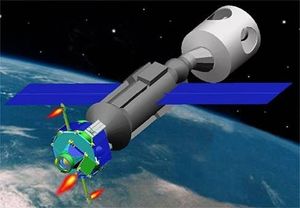
Interim Control Module
Encyclopedia

NASA
The National Aeronautics and Space Administration is the agency of the United States government that is responsible for the nation's civilian space program and for aeronautics and aerospace research...
constructed module designed to serve as a temporary "tug" for the International Space Station
International Space Station
The International Space Station is a habitable, artificial satellite in low Earth orbit. The ISS follows the Salyut, Almaz, Cosmos, Skylab, and Mir space stations, as the 11th space station launched, not including the Genesis I and II prototypes...
in case the Zvezda service module was destroyed or not launched for an extended period of time. It was derived from a formerly-classified Titan Launch Dispenser used to distribute reconnaissance satellites to different orbits. It would have been able to prolong the lifespan of the Zarya
Zarya
Zarya , also known as the Functional Cargo Block or FGB , was the first module of the International Space Station to be launched. The FGB provided electrical power, storage, propulsion, and guidance to the ISS during the initial stage of assembly...
module by providing equivalent propulsion capabilities to the Service Module, although not any of the other life support capabilities.
In 1997 NASA requested that the Naval Research Laboratory study the feasibility of adapting an existing, heritage spaceflight system to provide low-cost, contingency propulsion operations for the International Space Station (ISS).
After determining that the system could be adapted in time to meet NASA's schedule requirements, NRL was granted authority to proceed with the Interim Control Module (ICM). From its inception ICM was a contingency option for attitude control and reboost of the ISS that would allow NASA to preserve the on-orbit construction schedule in case of delays in the launch of the Russian Service Module.
ICM was to launch on board the Space Shuttle
Space Shuttle
The Space Shuttle was a manned orbital rocket and spacecraft system operated by NASA on 135 missions from 1981 to 2011. The system combined rocket launch, orbital spacecraft, and re-entry spaceplane with modular add-ons...
, deploy from the Shuttle's cargo bay, and mate with the ISS at the Russian Control Module (called Zarya). Once on orbit ICM would provide sufficient fuel for one to three years of operation.
ICM is in a caretaker status at NRL's Payload Processing Facility in Washington, D.C., and is being preserved in readiness in case it is needed for future ISS missions. NRL is studying alternative mission options for ICM.

